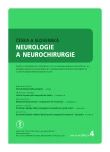Neuro-endocrine Dysfunction in Children and Adolescents after Brain Injury
Authors:
D. Aleksijević 1; J. Zapletalová 1; V. Smolka 1; E. Klásková 1; J. Wiedermann 1; D. Krahulík 2
; J. Vaverka 2; Z. Fryšák 3
Authors‘ workplace:
LF UP a FN Olomouc
Dětská klinika
1; LF UP a FN Olomouc
Neurochirurgická klinika
2; LF UP a FN Olomouc
III. interní klinika
3
Published in:
Cesk Slov Neurol N 2010; 73/106(4): 409-414
Category:
Short Communication
Overview
Background:
Neuro-endocrine dysfunction after traumatic brain injury is found in 23–60% of adult patients. Objectives: To evaluate growth, pubertal development and endocrine function in children and adolescents after traumatic brain injury. Patients and methods: We evaluated growth, pubertal development and bone age in 30 patients (18 boys) after traumatic brain injury. They underwent standard endocrine tests – thyreotropin, free thyroxin, insulin-like growth factor, prolactin, morning cortisol, gonadotropins, testosterone (in boys) and oestradiol (in girls). Dynamics tests were performed in patients with abnormalities revealed by clinical examination and/or laboratory results. Median patient age at the time of brain trauma was 9.7 (0.4–14.8) years; 75% of patients were prepubertal. Their range of Glasgow Coma Scale (GCS) was 3–12 (11 of these <8). Results: Diabetes insipidus was observed in three patients and syndrome of inappropriate adiuretine hormone secretion in a further three. The period since trauma ranged from 26 to 36 months (median 29 months). We found growth hormone deficiency in two boys (in one of them combined with thyreotropin deficiency and diabetes insipidus; precocious puberty in one girl (8.3 years) and one boy (7 years); and hypogonadotrophic hypogonadism in one adolescent girl masked by taking contraceptives pills. Conclusion: We found neuroendocrine dysfunction in 16.7% of patients. Brain-imaging techniques revealed abnormalities in most of them. We have started a prospective study in a large cohort of patients after traumatic brain injury, evaluating the frequency of hormonal disorder and its relations to the type of head trauma and the course of acute post-traumatic phase, with a view to identifying risk factors that predispose to hormonal disorder.
Key words:
traumatic brain injury – children – post-traumatic hormonal disorder – growth hormone deficiency – precocious puberty – risk factors
Sources
1. Cyran E. Hypophysisenschadigung durch Schadel-basis fracture. Dtsch Med Wochenschr, 1918; 44 : 1261–1270.
2. Escamilla RF, Lisser H. Simmonds disease (Hypophyseal Cachexia): Clinical Report of Several Cases with Discussion of Diagnosis and Treatment. Cal West Med 1938; 48(5): 343–348.
3. Agha A, Rogers B, Mylotte D, Taleb F, Tormey W, Phillips J et al. Neuroendocrine dysfunction in the acute phase of traumatic brain injury. Clin Endocrinol 2004; 60(5): 584–591.
4. Woolf PD. Hormonal response to trauma. Crit Care Med; 1992; 20(2): 216–226.
5. Benvenga S, Campenni A, Ruggeri RM, Trimarchi F. Clinical review 113: Hypopituitarism secondary to head trauma. J Clin Endocrinol Metab 2000; 85(4): 1353–1361.
6. Urban RJ, Harris P, Masel B. Anterior hypopituitarism following traumatic brain injury. Brain Inj 2005; 19(5): 349–358.
7. Agha A, Thompson CJ. Anterior pituitary dysfunction following traumatic brain injury (TBI). Clin Endocrinol 2006; 64(5): 481–488.
8. Aimaretti G, Ambrosio MR, Di Somma C, Gasperi M, Cannavò S, Scaroni C et al. Residual pituitary function after brain injury-induced hypopituitarism: a prospective 12-month study. J Clin Endocrinol Metab 2005; 90(11): 6085–6092.
9. Bondanelli M, De Marinis L, Ambrosio MR, Monesi M, Valle D, Zatelli MC et al. Occurrence of pituitary dysfunction following traumatic brain injury. J Neurotrauma 2004; 21(6): 685–696.
10. Klose M, Juul A, Struck J, Morgenthaler NG, Kosteljanetz M, Feld-Rasmussen U. Acute and long-term pituitary insufficiency in traumatic brain injury: a prospective single centre study. Clin Endocrinol 2007; 67(4): 598–606.
11. Sockalosky JJ, Kriel RL, Krach LE, Sheehan M. Precocious puberty after traumatic brain injury. J Pediat 1987; 110(3): 373–377.
12. Goldman M, Shahar E, Sack J, Meyerovitch J. Assessment of endocrine function in children following severe head trauma. Pediat Neurol 1997; 17(4): 339–343.
13. Niederland T, Makovi H, Gál V, Andréka B, Abrahám CS, Kovács J. Abnormalities of pituitary function after traumatic brain injury in children. J Neurotrauma 2007; 24(1): 119–127.
14. Einaudi S, Matarazzo P, Peretta P, Grossetti P, Giordano F, Altare F et al. Hypothalamo-hypophyseal dysfunction after traumatic brain injury in children and adolescents: a preliminary retrospective and prospective study. J Pediatr Endocrinol Metab 2006; 19(5): 691–703.
15. Poomthavorn P, Maixner W, Zacharin M. Pituitary function in paediatric survivors of severe traumatic brain injury. Arch Dis Child 2008, 93(2): 133–137.
16. Marshall WA, Tanner JM. Variations in the pattern of pubertal changes in girls. Arch Dis Child 1969; 44(235); 291–303.
17. Marshall WA, Tanner JM. Variations in the pattern of pubertal changes in boys. Arch Dis Child 1970; 45(239): 13–23.
18. Bláha P, Vígnerová J, Riedlová J, Kobzová J, Krejčovský L. VI. Celostátní antropologický výzkum dětí a mládeže 2001. Čes Slov Pediat 2003; 58(12): 766–770.
19. Greuliche WW, Pyle SI. Radiographic atlas of skeletal development of the hand and wrist. 2nd ed. Standfod: Stanford University Press 1959.
20. Ranke M. Diagnostics of endocrine function in children and adolescents. 3rd ed. Basel: Karger Publisher 2003.
21. Krahulík D, Zapletalová J, Fryšák Z, Vaverka M. Dysfunction of hypothalamo-hypophyseal axis after traumatic brain injury in adults. In press 2009.
Labels
Paediatric neurology Neurosurgery NeurologyArticle was published in
Czech and Slovak Neurology and Neurosurgery

2010 Issue 4
Most read in this issue
- Dynamic Magnetic Resonance Imaging of a Lumbar Spine – a Case Report
- Pharmacological Approaches to the Treatment of Epilepsy
- Treatment of Juxtafacet Cyst of the Lumbar Spine by Dynamic Interspinous Stabilization – a Case Report
- Functional Significance of a Temporal Lobe
